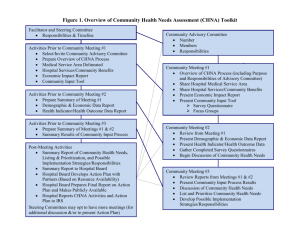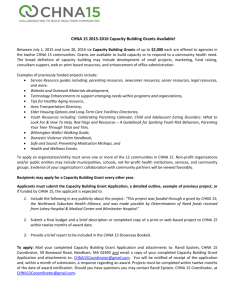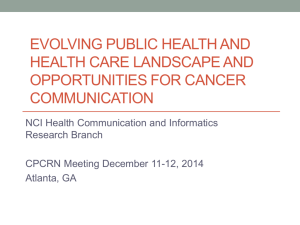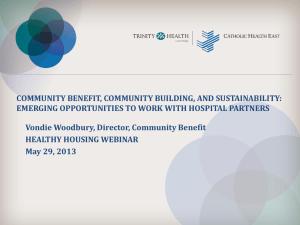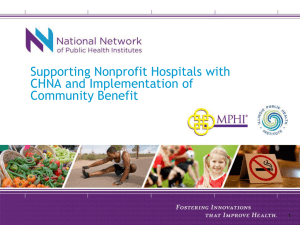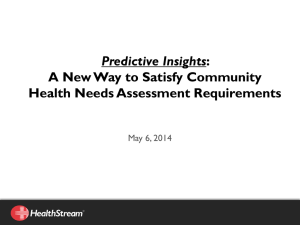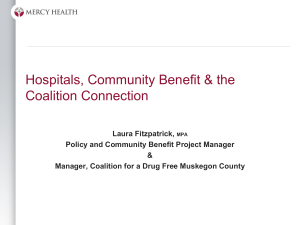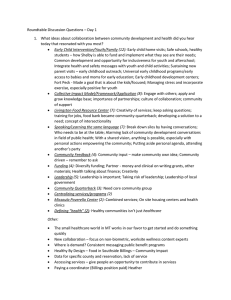Manchester Memorial Hospital & Rockville General Hospital Community Health Needs Assessment
advertisement
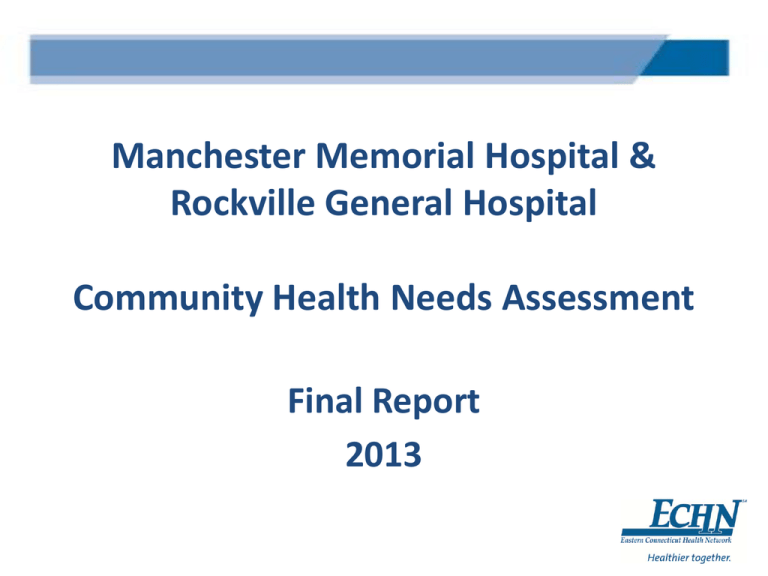
Manchester Memorial Hospital & Rockville General Hospital Community Health Needs Assessment Final Report 2013 Community Health Needs Assessment (CHNA) Overview Manchester Memorial Hospital (MMH) and Rockville General Hospital (RGH), as part of the Eastern Connecticut Health Network (ECHN), dedicate millions of dollars and thousands of staff hours to activities that enhance the overall health and wellness of their shared 19-town service area with special focus on the unmet needs of financially disadvantaged and underserved populations. In 2013, MMH & RGH collaborated to conduct a comprehensive community health needs assessment (CHNA). The goals of the assessment were: • To identify current and future healthcare needs in the community • To improve and strengthen programs and services provided to address them Community Health Needs Assessment (CHNA) The Community Served Community Health Needs Assessment (CHNA) The Community Served MMH & RGH share a 19-town primary and secondary service area located east of the Connecticut River in northern Connecticut with municipalities in Hartford, Tolland and Windham Counties. The primary service area, shaded in orange, includes any town where total inpatient and newborn discharges are ≥ 20 percent. The secondary service area, shaded in yellow, includes any town where total inpatient and newborn discharges are ≥ five percent and < 20 percent. Community Health Needs Assessment (CHNA) The Community Served Demographic Profile: Population: 341,499 people Gender: 48.9% male 51.1% female Age: Median age 39.5 years 33.3% 50 years or older Community Health Needs Assessment (CHNA) The Community Served Race Native American 0.2% Other/MultiRace, 6.1% Asian 5.3% Black 8.3% White, 80% Community Health Needs Assessment (CHNA) The Community Served Hispanic/Latino 9.4% Ethnicity White Not Hispanic/Latino 90.6% Community Health Needs Assessment (CHNA) The Community Served Education: 91.5% High school graduates 35.6% Bachelor’s degree or higher Average Household Size: 2.61 people Employment: 7.4% unemployment rate Median Household Income: Poverty Rate: $82,075 per year 7.6% Community Health Needs Assessment (CHNA) Demographic Summary: • The total service area population has increased 4% in two years. • Gender, Age, and Household Size are all very similar to CT and US ratios. • Compared to CT and US rates, the service area has a higher White population and a lower Black population percentage. • The Hispanic/Latino population percentage is lower than CT and US percentages. • The median household income is well above the state ($67,034) and national ($50,502) annual figures. •The unemployment rate is below that of the state (8.0%) and matches the nation. •Higher percentage of high school college graduates than CT (88.6%) and US (85.9%). Percentage who’ve earned a bachelor’s degree or higher matches the state’s percentage and exceeds the nation’s (28.5%). Community Health Needs Assessment (CHNA) The Assessment Process Community Health Needs Assessment (CHNA) The Process Oversight The CHNA initiative was steered by an Oversight Committee that included members of the ECHN organization, many who have established relationships with community groups and agencies. The Committee included: • • • • • • • • • • • • Senior Vice President, Planning, Marketing, & Communications President, Visiting Nurse & Health Services of Connecticut, Inc. Vice President , Patient Care Services Assistant Vice President, Patient Care Services Executive Director, Woodlake at Tolland Administrative Director, Women’s Services Administrative Director, Cancer Services Regional Director, Eastern Connecticut Medical Professionals Foundation Director, Patient Financial Services Community Benefit & Education Manager Quality Improvement Manager Market Analyst Community Health Needs Assessment (CHNA) The Process Secondary Data Profile Data from publicly available sources, including the US Census Bureau, Center for Disease Control and other community, civic and social service agencies, was collected to create a “secondary data profile,” which provides a statistical snapshot of the service area: o Demographics o Disease state profiles o Mortality statistics o Infectious diseases o Maternal health statistics o Environmental health statistics Community Health Needs Assessment (CHNA) The Process Community Health Survey A community health survey, modeled after the Center for Disease Control (CDC) Behavior Risk Factor Surveillance System (BRFSS) survey, was developed to gather information from service area residents on how lifestyle and behaviors affect health risks and outcomes. The survey was promoted and made available to residents in paper form and online. 1,047 responses received from service area residents 80% submitted on paper; 20% online Community Health Needs Assessment (CHNA) The Process Community Stakeholder Survey In February 2013, community agencies and organizations throughout the service area, representing a variety of medically underserved, low-income and minority populations, were invited to participate in an online survey, which asked: ● What is healthy about your community? ● What is unhealthy about your community? ● What is your perception of MMH/RGH and the programs and services it offers? ● What can MMH/RGH do to improve the health and quality of life in the community? Community Health Needs Assessment (CHNA) The Process Community Stakeholder Survey Responses received from: Agency/Organization Population Served WIC Program, Department of Public Health Community Child Guidance Clinic Low income and at nutritional risk women, infants and children Children & families with mental health needs Vernon Youth Services Bureau, Town of Vernon Youth Town of Ellington Human Services Town of Manchester Health Department Residents of Ellington; programs specifically for youth and elderly Residents of Manchester Town of Andover, Elder Services Seniors residing in Andover Maple Street School, Vernon children Bev’s Corner, Vernon General community Vernon Adult Education Vernon adults Indian Valley YMCA Families, including low-income MARC, Inc. People with developmental disabilities Community Health Needs Assessment (CHNA) Key Findings Community Health Needs Assessment (CHNA) Circulatory Disease Community Health Needs Assessment (CHNA) Key Findings Circulatory Disease Heart disease remains the #1 cause of death in the state; Stroke ranks third. Incidence rates are all similar to national rates: Circulatory Disease Incidence (2012 Estimates) Incidence Rates per 1,000 United States ECHN Total Service Area Angina Pectoris (New Only; Age 45+) 5.5 4.5 Cardiovascular Disease (New Only; Age 45+) 20.6 19.9 Heart Failure (New Only; Age 65+) 14.0 14.6 Myocardial Infarction (New Only; Age 35+) 7.1 7.7 Stroke (New Only; Age 55+) 9.1 8.7 Data Source: American Heart Association Community Health Needs Assessment (CHNA) Key Findings Circulatory Disease Community Health Survey respondents: High Blood Pressure (44.2%) & High Cholesterol (43.2%) were the top two health conditions reported. 8.1% report having Angina/Coronary Heart Disease 3.2% report having had a Heart Attack 3.0% Stroke Within the past year: 94.8% had Blood Pressure checked 81.3% had Cholesterol checked Community Health Needs Assessment (CHNA) Cancer Community Health Needs Assessment (CHNA) Key Findings Cancer Second leading cause of death in the total service area, CT, & US. Cancer Incidence (2012 Estimates) United States Connecticut ECHN Total Service Area Cancer (All Sites) 465.0 508.5 490.6 Breast (Female) 122.0 137.3 134.7 Colon & Rectum 46.2 47.2 48.6 Lung & Bronchus 67.2 68.0 66.0 Prostate (Male) 151.4 165.2 167.3 Incidence Rates per 100,000 Data Source: National Cancer Institute SEER Database Community Health Needs Assessment (CHNA) Key Findings Cancer Among All Cancer Sites: Incidence rate estimates above US, below CT rates Breast: Incidence rate above that of the nation but below CT rates Prostate: Incidence rate above CT and US Colon & Rectum: Incidence rate above CT and US 23.0% of community survey respondents reported never having had a colonoscopy Skin: 32.2% of survey respondents reported never having a skin cancer screening. Community Health Needs Assessment (CHNA) Diabetes Community Health Needs Assessment (CHNA) Key Findings Diabetes Total service area prevalence rate (per 100): 9.3 An estimated 60,000 to 93,000 adults have undiagnosed Diabetes. Higher incidence of Diabetes among Connecticut’s Black and Hispanic populations. Community Health Needs Assessment (CHNA) Diabetes Estimates Prevelance Rates (per 100) 2012 Rate vs 2017 Rate 9.3 TSA 11.0 9.3 CT 9.3 9.5 US 9.7 2012 2017 Community Health Needs Assessment (CHNA) Key Findings Diabetes Survey respondents: 15.0% report having been told they have Diabetes 79.9% have had their Blood Sugar checked in the past year Community Health Needs Assessment (CHNA) Musculoskeletal Disorders Community Health Needs Assessment (CHNA) Key Findings Musculoskeletal Disorders Higher incidence in the service area when compared with national prevalence rates. Prevalence Rates per 100 (Age 18+) United States ECHN Total Service Area Arthritis 21.1 22.8 Chronic Joint Pain 26.4 28.1 Lower Back Pain (Lumbar) 27.8 28.8 Lower Back Pain (Below Knee) 9.1 9.6 Neck Pain (Cervical Back Pain) 14.5 15.0 Data Source: Burdon of Musculoskeletal Diseases in the United States Community Health Needs Assessment (CHNA) Neurological Disease Community Health Needs Assessment (CHNA) Key Findings Neurological Disease Higher incidence rates of Alzheimer’s disease and Multiple Sclerosis compared to US Neurological Disease Incidence (2012 Estimates) Incidence Rates per 100,000 Parkinson's Disease (New Only; Age 65+) Alzheimer's Disease (Age 65+) Multiple Sclerosis United States ECHN Total Service Area 477.7 462.3 12500.0 13271.8 87.0 97.8 Parkinson’s Disease Data Source: Neuroepidemiology/Karger Alzheimer’s Disease Data Source: The Alzheimer’s Association Multiple Sclerosis Data Source: Neurology (Pub of the American Academy of Neurology) Community Health Needs Assessment (CHNA) Prenatal Care Community Health Needs Assessment (CHNA) Key Findings Prenatal Care The rate of “non-adequate” prenatal care is now similar to the state rate 2009 Connecticut ECHN Total Service Area ECHN Primary Service Area ECHN Secondary Service Area Intensive 35.9% 34.0% 33.2% 35.0% Adequate 44.3% 45.7% 47.0% 44.1% Non-Adequate* 19.8% 19.7% 19.2% 20.4% Prenatal Care Adequacy 2006 Connecticut ECHN Total Service Area ECHN Central Service Area ECHN North Service Area ECHN South Service Area Intensive 37.1% 31.8% 30.6% 34.1% 34.9% Adequate Non-Adequate* 43.1% 19.8% 43.7% 24.5% 42.7% 26.7% 47.7% 18.2% 45.2% 19.8%% Prenatal Care Adequacy Data Source: Connecticut Department of Public Health Community Health Needs Assessment (CHNA) Lyme Disease Community Health Needs Assessment (CHNA) Key Findings Lyme Disease Lyme Disease (2011) Connecticut ECHN Total Service Area ECHN Primary Service Area ECHN Secondary Service Area Total Cases 3,041 266 130 136 Rates per 100,000 89.3 77.9 75.3 80.5 Lyme Disease (2008) 2008 total cases 2008 rates per 100,000 Data Source: CT DPH 3,896 114.0 ECHN Total Service Area ECHN Central Service Area ECHN North Service Area ECHN South Service Area 432 143.2 134 69.6 92 290.7 206 258.5 Rates in the service area have decreased significantly compared to data collected three years earlier. Community Health Needs Assessment (CHNA) Childhood Lead Community Health Needs Assessment (CHNA) Key Findings Childhood Lead Fewer children in the service area are being screened for lead compared to state percentages Percentage of children with elevated level levels in the service area remain lower than the state rate. 2009 Connecticut ECHN Total Service Area ECHN Primary Service Area ECHN Secondary Service Area Percentage of Children Screened 31.6% 27.7% 26.0% 29.6% Percentage of Children with ug/dL greater than or equal to 10 0.9% 0.4% 0.5% 0.3% Data Source: CT DPH Community Health Needs Assessment (CHNA) Mental Health Community Health Needs Assessment (CHNA) Key Findings Mental Health Among Community Stakeholder Survey respondents: • 60% feel Substance Abuse is a serious problem • 50% feel Mental Health is a serious problem Community Health Needs Assessment (CHNA) Summary of Key Findings Community Health Needs Assessment (CHNA) Summary of Key Findings Circulatory Disease: Heart disease remains the #1 cause of death in the state and Stroke ranks third. The incidence rate of Angina Pectoris, Cardiovascular Disease, Heart Failure, Myocardial Infarction and Stroke are all similar to national rates. Cancer: Cancer continues to be the second leading cause of death in the service area, Connecticut, and the United States. Incidence rate estimates for Cancer (All Sites) and Breast for the service area are above that of the nation but below Connecticut rates. Prostate and Colon & Rectum cancer rates for the service area are above both the state and the nation. Diabetes: Estimated diabetes prevalence rates for 2017 show an alarming increase in the service area, while state and national estimates remain at or near 2012 rates. Connecticut’s Black and Hispanic populations suffer disproportionately from diabetes. Community Health Needs Assessment (CHNA) Summary of Key Findings: Musculoskeletal Disorders: There is a higher incidence of arthritis, chronic lower back pain, lower back pain, and neck pain in the service area when compared with national prevalence rates among individuals over the age of 18 years of age. Neurological Disease: There is a higher incidence of Alzheimer’s disease among service area residents over the age of 65 compared to national incident rate estimates. The incidence rate of Multiple Sclerosis is higher in the service area when compared to national figures. Prenatal Care: The rate of “non-adequate” prenatal care is now similar to the state rate, whereas the 2010 CHNA found it to be higher than state proportions. Community Health Needs Assessment (CHNA) Summary of Key Findings Lyme Disease: Lyme disease rates in the service area and state have decreased significantly compared to data collected three years earlier. The 2010 CHNA found incidence rates of Lyme disease, particularly in the secondary service area, to be significantly higher than that of the state. Total, primary and secondary service are rates are all now below state rate. Childhood Lead: Fewer children in the service area are being screened for lead compared to state percentages but the percentage of children with elevated level levels in the service area remain lower than the state rate. Mental Health: Community stakeholders reported overall mental illness to be a serious problem in the service area, including drug and alcohol abuse. Community Health Needs Assessment (CHNA) Identified Community Health Needs After reviewing the CHNA data, the Oversight Committee identified the following areas of need: • Heart Disease Incidence • Cancer Incidence • Diabetes Incidence • Arthritis Incidence • Alzheimer’s Disease Incidence • Multiple Sclerosis Incidence • Substance Abuse • Childhood Lead Screening Community Health Needs Assessment (CHNA) Priority Health Needs The Oversight Committee prioritized the CHNA’s identified health needs based primarily on the size and severity of a particular need, and also took into account the hospital’s ability to impact the need, and the availability of resources that exist to address it. Based on these criteria, the following health needs were given the highest priority: • Heart Disease Incidence • Cancer Incidence • Diabetes Incidence • Arthritis Incidence Community Health Needs Assessment (CHNA) Implementation Plan Strategies to Address the Health Needs Community Health Needs Assessment (CHNA) Strategies to Address Heart Disease Educate the public about managing lifestyle behaviors that impact diet, blood pressure, cholesterol, weight, physical activity, and stress. • Offer free community health educational programs • Provide education in Better Being, community free wellness magazine • Participate in community health fairs • Develop “Freedom from Smoking” smoking cessation program • Provide nutrition counseling services • Offer integrative medicine programs for stress reduction Community Health Needs Assessment (CHNA) Strategies to Address Heart Disease Provide information and services to individuals diagnosed with heart disease to help them best manage their symptoms • Develop “Heart Talk” community program for people living with heart failure • Promote Cardiac Rehabilitation services Community Health Needs Assessment (CHNA) Strategies to Address Cancer Monitor reports of newly- diagnosed cancer cases in the service area using the National Cancer Center Data Base (NCDB) to identify significant changes, trends or abnormal activity. Educate the public about managing lifestyle behaviors that impact cancer risks • Free community health educational programs • Articles in Better Being • Health fair participation • “Freedom from Smoking” smoking cessation program Community Health Needs Assessment (CHNA) Strategies to Address Cancer Provide free screenings through the community and access to follow-up care Offer comprehensive support programs for cancer survivors and caregivers • Oncology Nurse Navigator and Survivorship Navigators services • Annual Cancer Survivors Day event • Regular support group meetings • Cancer Caregiver Workshops Community Health Needs Assessment (CHNA) Strategies to Address Diabetes Raise awareness of diabetes preventable risk factors and educate the public on ways to manage lifestyle behaviors that affect them including diet, weight and physical activity • Free community health educational programs • Articles in Better Being • Health fair participation Offer Diabetes Self-Management Program and Nutrition Counseling for individuals already diagnosed with diabetes. Community Health Needs Assessment (CHNA) Strategies to Address Arthritis Educate the public about ways to help prevent or slow the progression of arthritis and manage the symptoms of joint pain. • Free community health educational programs • Articles in Better Being • Health fair participation Community Health Needs Assessment (CHNA) Strategies to Address Arthritis Offer free program to help individuals with arthritis prepare for hip or knee replacement surgery and achieve the best outcome. Develop a comprehensive surgical spine program to support individuals experiencing chronic neck and back pain including symptom management and perioperative care. Community Health Needs Assessment (CHNA) Community Collaboration An important component of these strategies will be collaboration with community resources including those currently available to respond to the health needs including: • • • • • • • • • • • • • • Cornerstone Foundation Eastern Highlands Health District Hockanum Valley Community Council, Inc. Johnson Health Network Manchester Area Conferences of Churches MARC, Inc. of Manchester Natchaug Hospital North Central Health Department Town Departments of Health & Human Services Town Departments of Social Services Tri-Town Shelter Services United Way Vernon Community Network Visiting Nurse and Health Services of CT Community Health Needs Assessment (CHNA) Measuring the Impact Community Health Needs Assessment (CHNA) Measuring the Impact Measureable impact of the above strategies will take time to materialize, however ongoing analysis of hospital utilization data for specific diagnoses, enrollment in hospital-sponsored education or disease management programs, feedback from community partners and reassessing community health needs in three years will assist in the evaluation of strategy effectiveness. Community Health Needs Assessment (CHNA) Approval Community Health Needs Assessment (CHNA) Approval The Community Health Needs Assessment and the strategies to address the priority needs identified (Implementation Plan) were reviewed and approved by the ECHN Strategic Planning Committee on August 21, 2013. The ECHN Board of Trustees reviewed and approved the CHNA and Implementation Plan on September 25, 2013.
